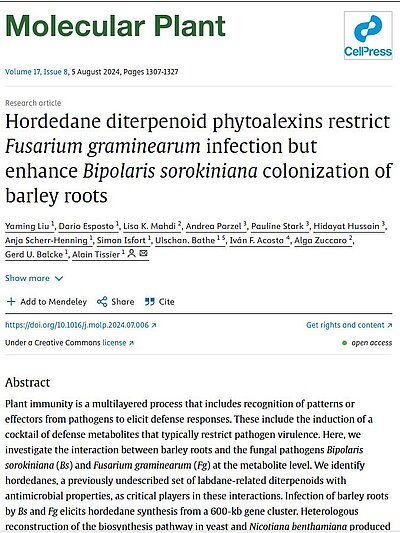Metabolic arms race between plant and fungus: New barley phytoalexins with amazing effects.
Plant pathogenic fungi pose a major threat to agricultural yields, a concern becoming increasingly relevant in our latitudes due to the warming of the northern hemisphere. IPB scientists, together with partners from the University of Cologne, have now shed light on the interactions of barley roots with the fungi Bipolaris sorokiniana and Fusarium graminearum. The two pathogens mainly attack monocotyledonous crops: While F. graminearum attacks the ears of wheat and barley, leading to shriveled grains, B. sorokiniana causes leaf spot diseases and root rot in both plants. Bipolaris is widespread in warm regions and is slowly migrating northwards.
When infected with the two pathogens, barley (Hordeum vulgare) expresses a number of genes that code for various biosynthetic enzymes of defense substances. Many of these genes had already been cloned and identified by the Halle-based scientists in earlier work. In their current study, they were now able to detect the defense metabolites produced by these enzymes in the roots and root exudates of the infected barley plants. The analyzed metabolites are cleistanthan-type diterpenes - a group of substances now described for the first time as barley phytoalexins. This finding reveals that barley, like maize and rice, can produce diterpene-based phytoalexins. The scientists named the novel class of barley phytoalexins “hordedanes”. In total, they were able to detect 17 different hordedanes in the infected barley roots.
By expressing the corresponding diterpene synthesis genes in yeast and Nicotiana benthamiana, the scientists successfully reconstructed the biosynthesis of hordedanes in yeast. Nine of the 17 hordedane compounds isolated from the barley roots could also be produced in yeast using this approach, confirming the accuracy of the reconstructed biosynthetic pathways. Knowledge of the genes involved in these metabolic pathways made it possible to specifically knock out these genes in barley, resulting in mutants that are no longer able to produce hordedane defense compounds. Infection of these defense-weakened mutants with the two fungal species should therefore result in uncontrolled growth of these plant pathogens. However, this was only the case with Fusarium graminearum. Interestingly, the fungus Bipolaris sorokiniana showed a rather reduced colonization of the barley mutants, despite the absence of fungicidal defense compounds. Thus, B. sorokiniana appears to exploit the hordedane phytoalexins originally produced to repel it.
This surprising finding was also proven in vitro. In a bioassay, the scientists investigated the effect of the most prominent hordedane compound 19-β-hydroxy-hordetrienoic acid (19-OH-HTA) on the two plant pathogens, as well as on three other harmful and beneficial fungal species. All fungal species tested, except for Bipolaris sorokiniana, exhibited significant inhibition of spore germination and hyphal growth after treatment with 19-OH-HTA. The hordedane compound thus acts as a broad-spectrum fungicide, but has no negative effect on B. sorokiniana. In fact, it slightly activates spore germination and strongly stimulates the pathogen's hyphal growth.
In further studies, the scientists found that Bipolaris sorokoniana can oxidize 19-OH-HTA and conjugate it to its own fungal sesquiterpenes. Transcriptome analyses of Bipolaris cultures with and without the addition of 19-OH-HTA showed a strong down-regulation of genes that play a role in cell lytic processes. As a hemibiotrophic pathogen, Bipolaris sorokiniana initially feeds on living plant cells before transitioning to a necrotrophic phase. The suppression of cell lytic genes may delay this shift, allowing the pathogen to continue multiplying in living tissue. In this very comprehensive study, the scientists impressively demonstrate how a pathogen not only evades the plant's immune system, but even exploits it to facilitate its own colonization. In essence, the pathogen breaks off the tip of the plant's spear and takes it for its own growth. The work clearly illustrates the complexity of interactions between pathogens and their plant hosts, which, driven by evolution, constantly lead to new counterattacks from both sides.



